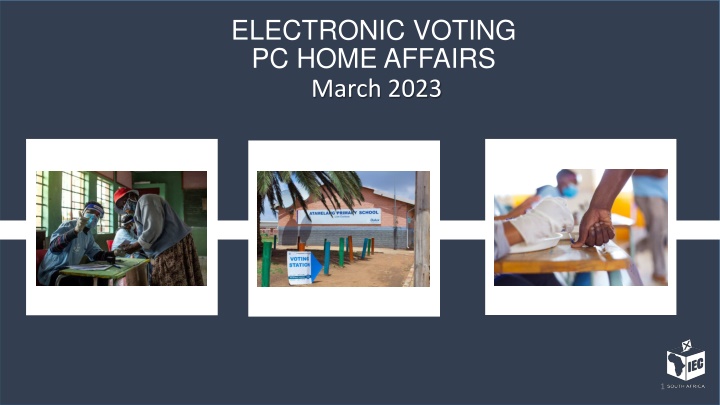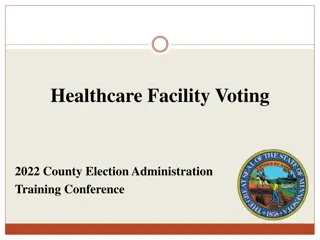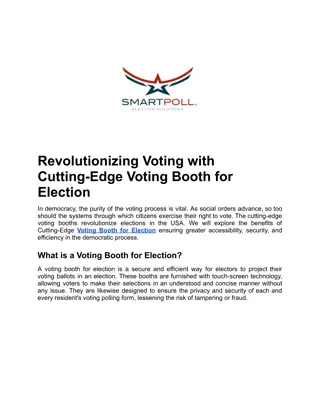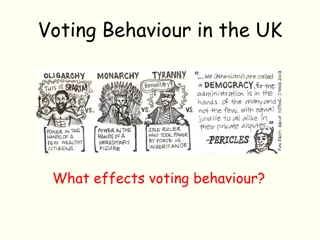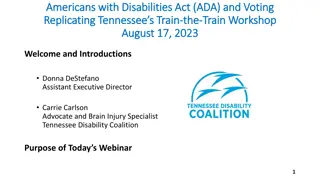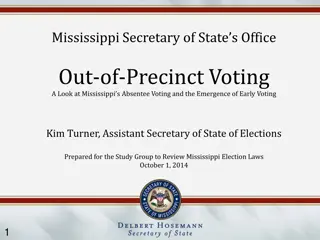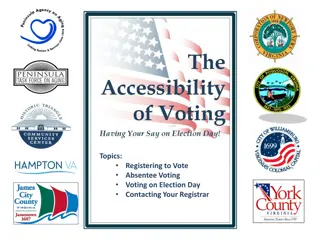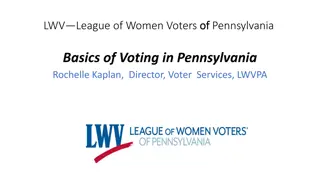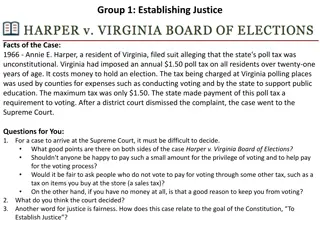ELECTRONIC VOTING PC HOME AFFAIRS March 2023
Delve into the realm of electronic voting systems with a comprehensive examination of defining e-voting, its types, global status, and valuable lessons learned from past experiences. Explore the controlled and uncontrolled environments of e-voting, including EVMs, DREs, and emerging technologies like internet voting and mobile phone voting. Gain a deeper understanding of the integrated devices that revolutionize ballot presentation, vote recording, and tabulation processes. Unravel the complexities and possibilities of electronic voting through a detailed exploration of its evolution and current landscape.
Download Presentation

Please find below an Image/Link to download the presentation.
The content on the website is provided AS IS for your information and personal use only. It may not be sold, licensed, or shared on other websites without obtaining consent from the author.If you encounter any issues during the download, it is possible that the publisher has removed the file from their server.
You are allowed to download the files provided on this website for personal or commercial use, subject to the condition that they are used lawfully. All files are the property of their respective owners.
The content on the website is provided AS IS for your information and personal use only. It may not be sold, licensed, or shared on other websites without obtaining consent from the author.
E N D
Presentation Transcript
ELECTRONIC VOTING PC HOME AFFAIRS March 2023 1
CONTENTS PAGE 1. Background 2. Defining e-voting 3. Types of e-voting 4. Global status quo 5. Analysis of e-voting types 6. Some lessons learnt 2
INTRODUCTION In addition to the study visits undertaken over some years, in 2010/11 Electoral Commission commissioned research (desk-top study) into the cross-national experience of electronic voting In March 2013 the Electoral Commission convened a conference on e-Voting Members of political parties represented in Parliament were invited to participate, together with interested civil society organisations Addressed by international experts on e-voting and representatives from EMBs involved in e-voting 3
DEFINING ELECTRONIC VOTING An electronic voting system may be defined as an integrated device that utilizes an electronic component for one or more of the following functions: ballot presentation, recording of vote & tabulation of votes cast
DEFINING ELECTRONIC VOTING E-Voting may be conducted in an environment that is under control of EMB, or an environment that is not controlled by an EMB E-Voting in controlled environment, such as a polling station, include EVMs (electronic voting machines of India) & DREs (direct recording electronics of Brazil) E-Voting in uncontrolled environments include internet voting, mobile phone voting, fax & email voting (France, Canada, Japan, Estonia & USA) 5
TYPES OF ELECTRONIC VOTING E-Voting in controlled environments EVMs or DREs: electronic voting machines or direct recording electronic located inside of polling station & administered by voting staff Voter directly enters choice into electronic storage using touch-screen, push buttons, key pad or similar device Votes cast are stored onto memory cartridge, diskette or smart card Used in India, Brazil, Venezuela, France, Russia, Japan & (parts of) USA 6
DIRECT RECORDING ELECTRONICS: BRAZIL DIRECT RECORDING ELECTRONICS: BRAZIL 7
ELECTRONIC VOTING MACHINE: INDIA ELECTRONIC VOTING MACHINE: INDIA 8
DIRECT RECORDING ELECTRONICS: Virginia, DIRECT RECORDING ELECTRONICS: Virginia, USA USA 9
TYPES OF ELECTRONIC VOTING E-Voting in controlled environments Voter Verifiable Paper Audit Trail (VVPAT) DRE VVPAT: an e-voting machine with added facility of printing piece of paper showing ballot choice of voters which are then placed in physical ballot box This allows for a manual re-count of ballots (audit trail) if votes are disputed In effect DRE VVPAT involves use of electronic voting machines in parallel to paper ballot voting method, with latter as a back-up should results be disputed & subject to re-count, which is not possible if only e-voting machine is used 10
DRE IN CONJUCTION WITH VVPAT DRE IN CONJUCTION WITH VVPAT 11
TYPES OF ELECTRONIC VOTING E-Voting in controlled environments Optical scans are electronic counting machines Votes are cast on paper ballots and fed into optical scanner which tabulates votes cast Used in Philippines in 2010 elections 12
TYPES OF ELECTRONIC VOTING E-Voting in un-controlled environments Internet voting: available at polling stations or any location with access to internet (remote internet voting) Estonia, Canada & France use remote internet voting Double envelope encryption used Voter s choice encrypted by voting application & placed in inner-envelope User signs name digitally & places details on outer envelope Outer envelope received centrally & name crossed off voters roll Inner encrypted envelope, which is anonymous, entered into digital ballot box for counting 13
SOME SENSE OF COSTS SOME SENSE OF COSTS Manufacturers of e-voting machines mainly located in USA, with some in Canada, India & Brazil Costs: EVM without VVPAT: $100 in India to $7 000 in New York EVM with VVPAT: additional $1 500 to cost of EVM 14
E E- -VOTING GLOBAL STATUS QUO VOTING GLOBAL STATUS QUO Polling station-based e- voting (e-voting machines) Remote e-voting (includes internet, fax &/or email) Abandoned e-voting Belgium Austria Australia Brazil Canada Germany France Estonia United Kingdom India France Ireland Japan Japan Netherlands Kazakhstan Switzerland Paraguay USA Philippines Russia UAE USA Venezuela 15
ANALYSIS ANALYSIS - - CONTROLLED CONTEXT DISADVANTAGES & WEAKNESSES E E- -VOTING IN VOTING IN CONTROLLED ADVANTAGES & STRENGTHS CONTEXT Fast & accurate count of votes cast High costs & limited shelf life (12 years) Reduces spoilt votes & over-votes Reduces voting transparency to public Multi-lingual ballot presentation Limits vote re-counts, except for EMV with VVPAT machines offering paper trail `Green option, carbon credits Needs extensive voter education Possible to manipulate machines through `hidden code or hardware (Closed code) Lack of consistent standards for certifying hardware & software of machines Most systems are closed to protect IP making auditing difficult Remote manipulation of system possible if system is connected or wireless Success dependent on public trust in the electoral process 16
ANALYSIS ANALYSIS - - INTERNET E- -VOTING REMOTE REMOTE INTERNET E VOTING ADVANTAGES & STRENGTHS DISADVANTAGES & WEAKNESSES Fast & accurate count of votes Voters may be unduly influenced or coerced when voting in private Improves voter access & convenience to the vote Easier for voter to sell vote when voting in private Reduces spoilt ballots & over-votes Hackers may trace vote cast to voter Longer term cost-savings after initial high costs covered Security of electronic data interception & modification of data by hackers Internet voting is ultimate `green election (savings of paper, energy, distribution & storage costs) Vote re-counts are difficult, without paper ballot trail May increase voter turnout High set up costs Reduced public transparency of voting process Lack of consistent & agreed standards for certification 17
LESSONS LEARNT LESSONS LEARNT General dearth of academic literature on e-voting The international experience on e-voting is mixed. There is no clear move towards or away from e-voting Security of e-voting is improving with technologies such as block-chain yet risks may remain Some countries are willing to accept the risks associated with e-voting (India, Brazil, USA, Canada, Japan), whilst others are not (Netherlands, Germany, UK, Australia, Ireland) 18
LESSONS LEARNT LESSONS LEARNT Decision to adopt e-voting is context-specific, influenced by size/geography of country, demographics, trust in EMB, political-legal culture, degree of tolerance of risks, etc When deciding, ensure that e-voting is suitable & most appropriate solution for country don t adopt e-voting because `everyone else is doing it & we want to look modern Should a decision be made to trial & pilot e-voting, transparency (open source software), inclusivity (buy-in of stakeholders) & trust (in EMB) are critical factors in successful implementation 19
LESSONS LEARNT LESSONS LEARNT Should e-voting be adopted, critical to ensure independent certification & audit of e-voting system to allow for independent confirmation of election results Should e-voting be adopted, critical to ensure well-trained voting staff, political parties & voters open, transparent process for stakeholder buy-in & confidence in system Process of introducing e-voting (transparency, inclusivity, stakeholder buy-in) is as important as the technicalities of e-voting product 20
THE END 21
